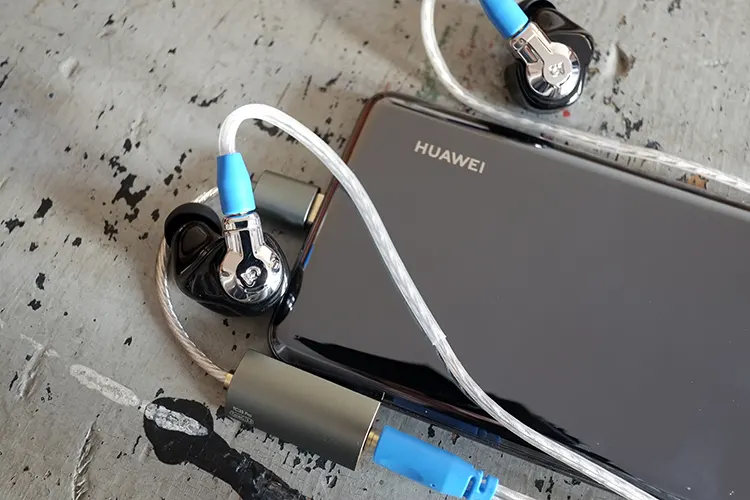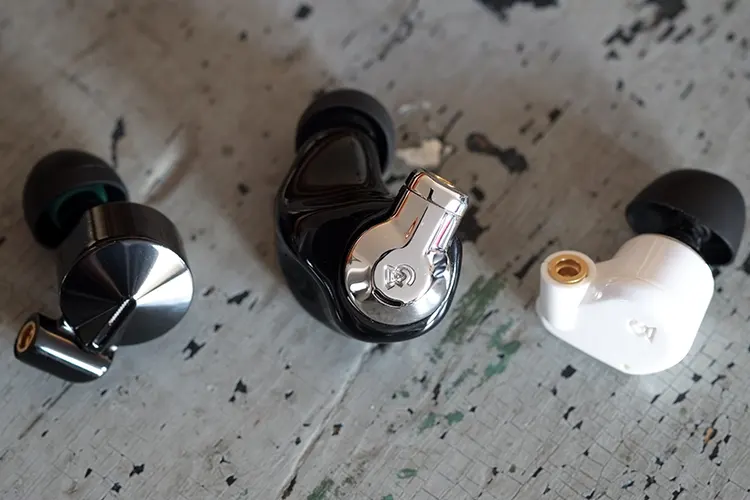Select Comparisons
Campfire Audio Vega 2020
Technical
The Vega 2020 and Cascara both contain 10mm dynamic drivers but with different tech.
The Vega 2020 uses a 10mm dynamic with an amorphous diamond-like carbon coating (ADLC). The Cascara’s newly developed 10mm dynamic has a more powerful dual-magnet design.
While they both have stainless steel nozzles, the build between the two is otherwise entirely different with the Vega 2020 utilizing a compact, ceramic shell. The Cascara features 3D-printed acrylic in a larger but more ergonomic shape.
Neither share T.A.E.C. nor any other common Campfire Audio tech, except for the copper/beryllium MMCX port that is standard across the lineup. The Solid Body Design philosophy used in the Chromatic Series is present on the Cascara, but of course not used on the Vega 2020.
The Vega 2020 requires 19.86 mVrms to attain 94dB SPL with a 1kHz weighting which makes it a little less sensitive compared to the Cascara which is rated at 16.6 mVrms. The Vega 2020’s impedance sits at 36Ω @ 1kHz compared to the Cascara’s 23Ω rating.
Design
The Vega 2020 is based on the original Vega’s design from late 2016 with a shell shape akin to a teardrop with a flattened portion on one side, and a small stem for the MMCX port.
As with the Cascara, a vent can be found on the rear to help relieve pressure on insertion, though on the Vega 2020, it is a pinhole vent.
Excluding the nozzle, the shells themselves are a glossy white ceramic. Fit and finish are flawless, and thanks to the durability of the ceramic, they look as good now as they did when I first reviewed them in 2021.
Thanks to the Solid Body Design that uses the internal cavities and driver structurally, the Cascara’s 3D-printed acrylic shells look nice and should be plenty durable.
I prefer the shock-white look of the Vega 2020 to the more subtle Cascara, at least in black. If my sample were blue, it might be a different story.
The footprint of the Vega 2020 is similar in size to just the chrome backing of the Cascara, highlighting just how compact they are.
This compactness translates to a more universal fit across various ear types. I found the Cascara more comfortable as the ear-filling shell better distributes the weight of the earphone and cable.
Due to the difference in nozzle circumference, the same tips could not be used to test isolation. For the Vega 2020, I adopted ADV’s Eartune Fidelity tips with a wide bore and similar silicone density.
To my surprise, the Vega 2020 isolated better, and not far off what I expect from a sealed armature-based earphone. In the same environments, I could use the Vega 2020 without needing to raise the volume to counter outside noise.
Performance
The Vega 2020 provides a similar level of extension to the Cascara but with a lower quantity of sub-bass, and a more prominent mid-bass. Notes are more weighty, slower, less textured, and hit with a less visceral impact compared to the Cascara.
The extra mid-bass also produces an even warmer, boomier, low-end presentation. Unlike on the Cascara where the bass blends in naturally with the rest of the signature, the Vega gives off a sub-woofer vibe that is somewhat disjointed from the rest of the tune.
Heading into the mids, they are considerably more forward on the Cascara and do not play second fiddle to the low-end. Notes are thick and weighty but remain crisp and detailed.
Mids on the Vega 2020 are in comparison recessed and lean, though detail and overall clarity are on par which keeps vocals from being overshadowed by the mid-bass. Still, the Cascara’s bass/mid-range balance makes it a more versatile product.
Treble is another area where the two differ considerably with the Vega 2020 having more brilliance region emphasis. The result is plenty of shimmer and high-pitched tingle in places where the Cascara is dull.
This also means the Vega 2020 sounds even more spacious and open. The upper-end airiness and sparkle combined with a lean midrange produce a stage that affords more space between instruments and notes.
Imaging accuracy is similarly good between the two, with the Vega 2020 having the edge thanks to the larger staging. That quality also gives it an edge in layering and instrument separation, though the difference is minor.
The Vega 2020 is a good-sounding earphone with some desirable qualities, however, the recessed mids and fragmented low-end result in a less refined and less versatile tune than what the Cascara offers.
DUNU Zen
Technical
The DUNU Zen’s shells are made from CNC-machined stainless steel and are heavier despite being smaller. The Cascara is mostly 3D-printed acrylic with stainless steel being used for the nozzles and rear plate.
Inside the Zen is a large, 13.5mm dynamic driver. It has a magnesium-alloy dome with nanoDLC coating and an unusually strong “neodymium-based magnet assembly that achieves over 1.8 T magnetic field strength at the voice coil.”
The magnet’s strength is very evident in the way the shells stick together, and in the way outside objects are negatively influenced, such as the scale I use to weigh earphones and other products.
The Cascara’s driver seems simple in comparison and uses their new 10mm dynamic based around a dual-magnet design. No special technology or buzzwords are noted in the product information.
Design
DUNU’s Zen has a traditional look, with a small, round, vented face and a protrusion to accommodate the MMCX ports. It has a footprint only slightly larger than the chrome backing on the Cascara.
The Zen’s shells are painted in glossy black and as such, it lacks any special identity or unique design features. This understated look might work for some, but I appreciate the little flair that the Cascara’s chrome backing provides.
The Zen’s shells are made of stainless steel with the sort of blemish-free fit and finish this price range demands. The Cascara is acrylic and steel and built to the same exacting standards with an equally flawless fit and finish.
My copy of the Zen is three years old now and is still free of any chips or signs of damage. Simply due to the materials in use, I would expect it to last longer than the Cascara’s acrylic, but again, only time will tell.
The small size of the Zen allows it a more universal fit across varying ear types and sizes. It comes with a heavy cable though, and the design does not support the weight very well.
As such, the Cascara and its quasi-universal shells take the proverbial comfort cake. It provides a good seal all the time and manages the weight of the earpieces and cable with no issue.
While both earphones contain dynamic drivers with similarly sized rear vents, the Zen isolates better in the same environments with the same tips. Whereas I can hold a conversation with someone when wearing the Cascara, I can’t with the Zen.
Performance
These two earphones are oddly complementary. Their tuning is well-matched from the mid-range up.
The Zen provides considerably less bass than the Cascara. Sub-bass roll-off occurs sooner and it provides a less visceral experience.
However, notes hit harder, and decay is faster with even better control and texturing. Balance from lower to upper bass is more even, giving the Zen a cooler tone from bottom to top.
The mid-range tuning is near equal with a similar 3k drop to prevent fatigue, though up to 4k the Cascara holds more emphasis giving it a slightly brighter sound and more aggression on drums and other rhythmic instruments.
Heading into the upper ranges, both models place focus on the presence region with moderate extension and emphasis on the brilliance region. Neither is particularly sparkly, though they both offer plenty of detail and clarity.
I’d have to give the edge to the Zen for those last two qualities. The detail and clarity come at the expense of added fatigue at higher volumes and on harsh tracks that the Cascara handles better.
The soundstage of the Zen is average but more evenly rounded. While the default vocal positioning is placed further out than on the Cascara, sounds fail to spread out as far to either side nor is there the same level of depth.
This is countered by more precise imaging and a leaner presentation. Despite the smaller overall stage size of the Zen, instruments are better separated and there is a greater sense of layering.
When it comes down to it, the Cascara is the more fun-sounding model, and the Zen is the more technical one. Someone could happily own both because of the mid and upper-range tuning, then choose the one that offers the bass presentation they want at that time.
Our Verdict
Campfire Audio isn’t a brand that limits itself to one basic signature that caters to one style of listener. The Cascara is a testament to this and brings a refined, bass-focused sound to those wanting it in a more premium product.
It is tuned in a way that is both technically strong, with a great soundstage and accurate imaging, but still entertaining thanks to prominent vocals and an emphatic low end.
It’s not fatiguing or harsh, though the lack of upper treble sparkle may leave you wanting more depending on your preferred music genre.
It also looks nice and is comfortable to wear, pending it’s not too big for your ears. Isolation is average, but a small bump in volume or using the included Mushroom foam tips can help combat this.
This is an excellent follow-up to models like the Vega 2020 and Atlas and would be an ideal upgrade for those wanting to upgrade from the humble Honeydew.
Campfire Audio Cascara Technical Specifications
- Frequency Response: 5Hz–20 kHz
- SPL: 94 dB @ 1 kHz: 16.6 mVrms
- Impedance: 23 Ohms @ 1 kHz
- Less than 1% Total Harmonic Distortion




